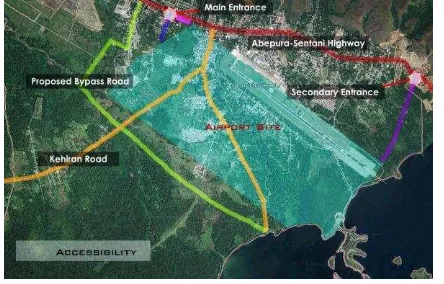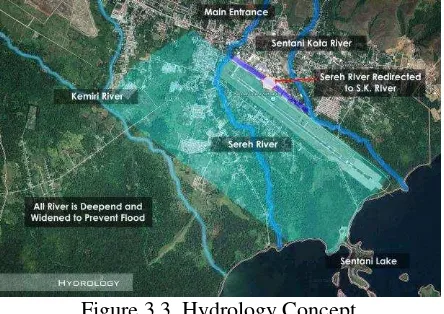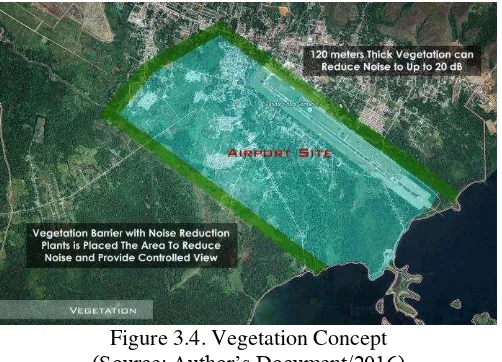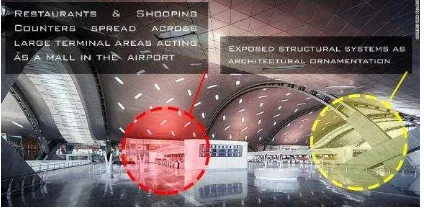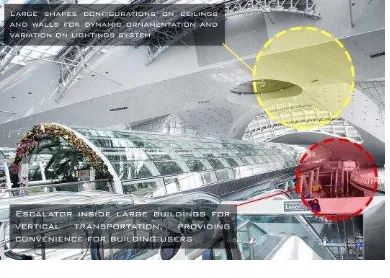INTERNATIONAL AIRPORT OF SENTANI, PAPUA
(Green & Sustainable Architecture Approach)
PAPER OF PUBLICATION
Submitted in partial fulfillment of the requirements of a Bachelor Degree
on Architectural Department, Faculty of Engineering
University of Muhammadiyah Surakarta
Author:
RILO ALIEF SADEWA D 300 120 086
ARCHITECTURAL DEPARTMENT
FACULTY OF ENGINEERING
INTERNATIONAL AIRPORT OF SENTANI, PAPUA
(WITH GREEN AND SUSTAINABLE ARCHITECTURE APPROACH)
Rilo Alief Sadewa
(Student of Architecture on University of Muhammmadiyah Surakarta) Email : [email protected]
Abstract
Means of transportation and buildings ranked as the second and third worst destructive factors of nature due to human activities, where the first position is occupied by coal and diesel power plant (Natural Resources Defense Council (NRDC), 2005). Indonesia which is touted as the lungs of the world is required to be sensitive and responsive to environmental problems. Papua as one among the largest provinces in Indonesia has shortcomings in terms of infrastructure to facilitate the activities of aviation. Based on elucidation of the background of the study, an environmentally friendly international airport design based on standardized green and sustainable principle is required. In order to realize the design in the best possible result, proper basic analysis is conducted based on data of Jayapura region obtained from field survey in the early stage of the design. The first step of the analysis is to determine an appropriate location as the site for further development of the design. Then, analysis of the chosen site which includes analysis of accessibility, topography, hydrology, vegetation, sun, wind, view, circulation, weather and zone. From the results of these basic analysis, green & sustainable concept is applied in accordance to aspects and standards issued by legal entities which dedicated to the cause. This is done to maximize the efficiency and effectivity of the fundamental concept. In order to complement the sophistication of the technology intended for the green and sustainable concept, architectural concept which is chosen for the design is futuristic style. The last step, is performing an assessment of space and room as well as the area of each item to determine the connection of each individual space to the other.
Keywords: International Airport, Papua, Green, Sustainable, Environment
Abstrak
pada tahap awal desain. Langkah pertama dari analisis ini adalah untuk menentukan lokasi yang tepat sebagai site untuk pengembangan desain lebih lanjut. Kemudian, analisis site yang dipilih yang mencakup analisis aksesibilitas, topografi, hidrologi, vegetasi, matahari, angin, lihat, sirkulasi, cuaca dan zona. berdasarkan hasil analisis dasar ini, konsep hijau & berkelanjutan diterapkan sesuai dengan aspek dan standar yang ditetapkan oleh badan hukum yang berdedikasi untuk permasalahn terkait. Hal ini dilakukan untuk memaksimalkan efisiensi dan efektifitas dari konsep dasar. Dalam rangka menyesuaikan kecanggihan teknologi yang ditujukan dalam konsep hijau dan berkelanjutan, konsep arsitektur yang dipilih untuk desain adalah gaya futuristik. Langkah terakhir, adalah melakukan penetapan kebutuhan ruang serta luas yang dibutuhkan setiap ruangan, untuk menentukan koneksi dari setiap ruang terhadap ruangan yang lain.
Kata Kunci: Bandara Internasional, Papua, Green, Sustainable, Lingkungan
1 INTRODUCTION
1.1Background of the Study
1) International Airport
The system of civil aviation, particularly airports as its crucial facility, has
come to be the most substantial element of transportation and one of the main
requirements to 1900s trade and market. The commercial division of civil
aviation, containing more than 900 airlines and 22.000 aircraft, had become the
choice of transportation to more than 2 billion passengers and carried 85
million tons of cargo on more than 74 million flights to more than 1700
airports in more than 180 countries worldwide, in 2008 alone (Horonjeff,
2010).
2) Environmental Effect of Aviation Activities
Airport and aircraft activities are one of the main source of damage to the
ecosystem that has been happening around the world. Means of transportation
and buildings ranked as the second and third worst destructive factors of nature
due to human activities, where the first position is occupied by coal and diesel
power plant (Natural Resources Defense Council (NRDC), 2005). Utilization
of fossil fuel for transportation and diesel powered generator to fulfill the
energy requirements of buildings throughout the world contribute to
3) Papua and International Airport
Indonesia which is touted as the lungs of the world is required to be sensitive
and responsive to environmental problems. Although various measures have
been done to create environmentally friendly means of transportation and
buildings, the results attained in Indonesia is considerably low from
expectation. This matter is caused by the indifference of Indonesian
government and its people as a whole, in addition to the low level of
effectiveness of the measures taken by the government as well as the lack of
proficient human resources.
4) Identification of the Problem
Based on elucidation of the background of the study, to overcome the
problems of low quality airports in Indonesia and particularly in Papua, as
well as the negative impact of the existence of airports and aviation activities
to the nature, an environmentally friendly international airport design based on
standardized green and sustainable principle is required. The result is hoped to
be a role model of high quality airport and pioneer of green airport and green
building as a whole in Papua and Indonesia for its purpose in preservation of
the environment as well as educational needs.
1.2 Objectives
Objectives in the design of ‘International Airport of Jayapura, Papua with
Green and Sustainable Architecture Approach’ are:
1. Deliver a building area that can accommodate international airport activity
and its auxiliary facilities at an appropriate location in Jayapura.
2. Achieve a green and sustainable international airport design which include
the following aspects:
a. Undemanding energy requirements.
b. Availability of alternative energy source on site.
c. Appropriate waste management.
d. Application of environmentally friendly building material.
e. Located on a specific distance from residence or city area to minimize
f. Buildings layout design to increase the efficiency of aviation acivity
and all of it’s supporting elements.
g. Airport design that follow specific standards of green and sustainable
design issued by legal government or private entitites.
2 METHOD OF THE STUDY
Method of the study is conducted through a few stages, which are:
1) Theoretical Study
The study of literature, which is the taking information and knowledge from
several sources concerning international airport and sustainable design that can
be used to address each problem found in the design process with a solution.
2) Data Accumulation
Data required in the design of ‘International Airport of Jayapura, Papua with
Green and Sustainable Architecture Approach’ are as follows:
a. Data of existing airport
b. Regional data and statistics related to airport
c. Data and information regarding international airport
d. Data and information regarding green and sustainable building design
particularly airport.
3) Analysis
Analyzingg physical and non-physical data required, which then used as
consideration in the design of ‘International Airport of Jayapura, Papua with
Green and Sustainable Architecture Approach’.
4) Planning & Design Concept
Creating a basic concept or planning to use descriptive method to clarify and
reinforce one another that are embodied in a concept of planning and design.
3 RESULT AND DISCUSSION
3.1 Appropriate Sentani International Airport Design
Sentani International Airport concept is meant to be the role model of a modern
and sophisticated airport while also promotes concern and interest in the
and even Indonesia as a whole. Apart from green & sustainable, major airport
specification ideas that will be applied to the design are as follows:
1) Runway
2) Taxiway & Apron
3) Terminal
4) Hangar
5) Air Traffic Control System
6) Security Systems
7) Emergency Response Team Service
8) Airport Ground-Vehicles
9) Additional Airport Services
Due to unavailability of another site option for airport location, which have
been discussed earlier in previous chapter, this design will use the existing site
of Sentani Airport.
1) Land Requirements
Based on analysis in this aspect, measures that will be taken are as follow:
a. Expansion of airport area to fulfill its capability in accommodating
aviation activity on an international level.
b. Final result (Color Legend Explanation: red – runways, blue – apron and
taxiway, orange – building area):
Figure 3.1. Rough Estimation of Area Expansion (Source: Author’s Document/2016) 2) Accessibility
The purpose of this analysis is to provide adequate entrances to ease
a. Main Entrance
a) Main entrance is located in Abepura-Sentani Highway. Placed quite
far to increase circulation length and prevent jamming.
b) Main entrance will accommodate entry and exit point with each point
has 3 lanes for maximum capability.
b. Secondary Entrance
a) There are more than one secondary entrances to the site to provide
more flexibility for technical and service activity.
b) The first SE is located on the north side to the site and a little to the
east from north runway.
Figure 3.2. Entrance Concept (Source: Author’s Document/2016) 3) Topography
The purpose of this analysis is to provide suitable measures to the contour
condition of the site.
a. Contour manipulation around the airport to increase rainfall flow.
b. Increasing number of vegetation around the site to improve soil ability to
absorb rain water.
4) Hydrology
The purpose of this analysis is to identify, utilize, and preserve natural water
bodies around the site.
a. Protection of all water body from any kind of pollution
b. Sereh River is redirected to and united with Sentani Kota River. Both river
is enlarged and deepened to prevent flood in the future.
c. Kemiri River is enlarged and deepened to prevent flood in the future.
Figure 3.3. Hydrology Concept (Source: Author’s Document/2016)
5) Weather
The purpose of this analysis is to ensure all design elements is suitable and adaptable to climate condition of the area, therefore there won’t be any weather related problem in the future.
a. Climate & temperature adaptation measures:
a) Utilization of tropical plants for vegetation purpose.
b) Indoor temperature is controlled with air conditioner.
c) Outdoor temperature comfort is provided with maximizing green area
around the most potentially crowded and working areas.
b. Sun adaptation measures:
a) Utilization of high-albedo material to maximize sun radiation and
light reflection, preventing heat island effect.
b) Energy use reduction with the use of sunlight for indoor natural
lighting on all buildings.
c) Sun shading for sunlight filter, providing more control over sunlight
intensity and radiation.
d) Provision of roof for pedestrian way for shelter against the sun.
c. Wind adaptation measures:
a) Management of building orientation layout for maximizing wind flow
in the area by reducing any form of wind barrier-like building
surface/façade.
b) Utilization of vegetation as wind filter/barrier for reducing wind
c) Relatively slow and controlled wind (with vegetation) can be used for
providing clean and fresh air into buildings.
d. Rain adaptation measures:
a) Provision of drainage system and certain amount of topographical
manipulation to maintain consistent flow of rainwater, preventing
regional flooding in the site.
b) Harvesting and treating rainwater as a source of clean water, reducing
the use of potable water.
c) Building’s roof is tilted to a certain degree to maximize rainwater flow
and reduce rainwater load to the structure.
d) Provision of shelter on the form of roof for all outdoor pedestrian area
for protection against rainwater.
6) View
The purpose of this analysis is to better viewing experience and increase
overall site aesthetic value.
a. Building is design with highly-aesthetical and stand out façade/color.
b. Moderate lighting effect on the building to increase viewing capability of
the area from outside.
c. Emptying several parts of north region along the site boundaries to be used
as green region with tall and dense vegetation.
d. Aside from the north area, because of the high viewing value of airport’s
surrounding environment, building orientation and window size &
placement can be done quite freely.
e. Garden and other aesthetical elements inside the site to increase viewing
value in a wide airport area.
7) Noise
The purpose of this analysis is to provide better site environment in terms of
noise intensity and reduce noise pollution.
a. Utilization of green area around the airport to reduce noise pollution from
and to the airport site.
b. Preservation & enhancement of forest around the area as the most
c. Relocation of residential and office area to provide a safe distance from
noise pollution caused by aviation activity.
d. Noise-reduction material is used to reduce noise level inside the terminal
and office area.
e. Utilization of low noise facilities and equipment.
8) Vegetation
The purpose of this analysis is to maximize the size and efficiency of green
area inside the airport site.
a. Preserve and intensify as much as possible forest features around the
airport site.
b. Increase the number of vegetation variety with different features to achieve
intended goals. Plants used in the design must be able to live in tropical
climate and non-toxic in anyway. These plants are divided to groups based
on their advantages.
c. Provide, wherever possible, a green area to increase outdoor environment
quality across airport area.
Figure 3.4. Vegetation Concept (Source: Author’s Document/2016)
3.2 Green & Sustainable Airport Concept
Green & Sustainable concept is arranged using summary of key elements
discussed previously in chapter 2, based on the existing condition of Sentani
Airport environment.
1) Sustainable Site
Eliminate all from of disturbance and harm caused by the existence of airport
a. Reduction of Air Pollution.
b. Nature Preservation.
c. Storm Water Management
d. Light Pollution Reduction
2) Heat Island Effect Reduction
a. Minimize paved/hard surface.
b. Most of parking area is placed under cover.
c. Utilization of light colored/high albedo materials for roofs, walls and
hardscapes to increase the surface ability to reflect heat.
d. Area where the use of paved surface is required, shelter is provided
with roof lined with solar photovoltaic panels or vegetation.
3) Water Management
a. Implementation of dry fixtures including composting toilets and
waterless urinal to reduce the use of water.
b. Alternative water source from grey water (from lavatories, showers,
washers, and sinks) and rain water.
c. Vegetation in the site are drought tolerant or do not need much water.
d. All form of water treatment is done inside the airport area.
e. Irrigation is controlled via computer system.
f. Application of low-flow, high-efficiency plumbing fixtures.
g. Slow intercept and encourage infiltration, reuse, protect and treat
stormwater whenever possible to minimize contamination and runoff.
h. Minimize the use impervious surface materials, incorporate vegetated
roofs, curb breaks and bioswales.
i. Treated waste water is used to recharge aquifer.
4) Energy & Atmosphere Management
a. Design of airside and landside area is improved as much as possible in
terms of its simplicity to increase the efficiency of airport operations.
b. Optimization of energy performance by providing high efficiency
motors, pumps, systems and equipment.
c. Energy highly-efficient lighting such as LED and solar powered lights
d. Automation of lighting control system with occupancy sensors for toilet
rooms, storage, equipment rooms, stairs, conveyors, and escalators.
These system is controlled from distinctive rooms.
e. Utilization sunlight for buildings natural light, heat, absorption cooling
and ventilation.
f. Minimize energy loss for all buildings.
g. Provide daylight harvesting control systems.
h. Utilization of renewable energy.
i. Optimize architectural features for daylighting and glare control.
j. Eliminate the use of CFC-based refrigerant, which then replaced with
natural refrigerant.
k. Reduce or eliminate the use of refrigerant.
l. Metering equipment to supervise energy use on all part of the airport.
m. Alternative heating and cooling system for air and water (will be
discussed in a separate part)
5) Indoor Environmental Quality Control
a. Prevent or minimize all form of exposure to environmental tobacco
smoke (ETS) control
b. Smoking is limited and even prohibited within the area.
c. Increase air circulation of all buildings with natural ventilation.
d. Low emitting materials is used for all interior need.
e. Provide a high level of lighting and thermal control system.
f. Provide for the building occupants a connection between indoor spaces
and the outdoors through the introduction of daylight and views into the
regularly occupied areas of the building.
g. Reduce noise levels in noise-sensitive, occupied areas such as passenger
terminals and offices with sound dampening systems, glazing and space
design.
6) Generation and/or Integration of Renewable Energy
a.Concept:
The photovoltaic panels are implemented in the form of
efficiency and reduce the need of specific solar power plant area, as well
as to increase buildings aesthetical value.
b.Water Power
The joined stream of Sereh & Sentani Kota Rivers is used for micro-hydro
power plant. The energy produced in this system is also considered green
and renewable. The energy harnessed in this system is stored for
emergency needs.
c.Geothermal Heating & Cooling
For alternative cooling and heating system, geothermal power is used.
7) Materials & Resources
a. Provision of easily accessible facility specifically intended for the
collection, storage and recycle of buildings waste.
b. Provision of water dispenser system of potable water refuel to reduce
the amount of water bottle waste.
c. Recycle and reuse any construction materials as much as possible,
during construction process.
d. Divert waste from landfill disposal.
e. Distribution of surplus food to those in need
f. Elimination of petroleum based plastic bags
g. Utilization of materials which can be extracted, harvested,
manufactured or recovered within 900 km (CDA standard) radius of the
project site, thus supporting the use of indigenous resources.
h. Rapidly renewable materials and durable equipment & furniture to
reduce the need of replacement.
8) Alternative Fuel & Vehicles
a. Maglev Train
b. Electric and Solar-Powered Bus
c. Airport ground vehicle can also be replaced with an electrical one,
with the same system as commercial electric car.
3.3Architectural Concept
1) Architectural Style
Architectural style that is used as a basis of aesthetical design of the airport is
futuristic architecture.
2) Layout & Building Configuration Concept
Figure 3.5. Final Layout & Rough Buildings Configuration (Source: Author’s Document/2016)
3) Concept Application on Interior
Figure 3.6. Interior Features Example 1 (Source: Author’s Document/2016)
Figure 3.8. Interior Features Example 3 (Source: Author’s Document/2016)
4) Concept Application on Landscape
Design ideas on airport landscapes divided to hardscapes, waterscapes and
softscapes. The goal is to deliver a harmonized collaboration from the 3 main
elements. Concept on these 3 elements are:
a. Hardscapes
Figure 3.9. Hardscapes Features Example (Source: Author’s Document/2016) b. Softscapes
c. Waterscapes
Figure 3.11. Waterscapes Features Example (Source: Author’s Document/2016)
4 CLOSING
International airport of Sentani (with green & sustainable architecture) in
District of Jayapura, Papua is an an airport that offers customs and immigration
facilities for passengers travelling between countries which design to be
environmentally friendly because both the structure and the use of processes are
environmentally responsible and resource-efficient throughout a building's
life-cycle: from siting to design, construction, operation, maintenance, renovation,
and demolition that is located in the capital city of Indonesia’s largest and
easternmost province, Papua. This airport design is an answer to a cry for
appropriate aviation facilities in Papua which a large amount of its region rely
heavily on air transportation for a way to make contact to the outside, as there
are no other means of transportation. Moreover, as a developing region, Papua
can adopt the concept and measures taken in this design, not only in its airport
aspect but also green & sustainable mindset as a whole for its development in
the future and as a way to contribute to world cause in environmental health.
BIBLIOGRAPHY
A380 Airport Compatibility Group (AACG), 2004. Airbus A380 Operations at
Alternate Airports, 2004. Montreal, Canada
Adisasmita and Hadipramana, 2011. Improving The Airport Operation And
Cooperative Development of Operational Safety and Continuing Airworthiness –
South Asia, 1999. Aerodrome Standards, 1999. South Asia.
Federal Aviation Administration, 2016. FAA Guide to Ground Vehicle Operations
(A Comprehensive Guide to Safe Driving on the Airport Surface), 2016.
Chicago, Illinois.
Grand Forks Municipal Airport, 2004. ND Airport Operations Manual 2004.
North Dakota.
Horonjeff, Mckelly, Sproule, Young. 2010. Planning & Design of Airports (Fifth
Edition), 2010. New York.
King County International Airport, 2007. Airport Minimum Standards, 2007.
